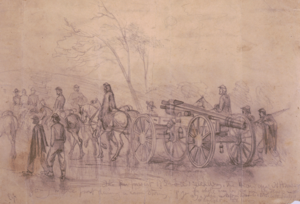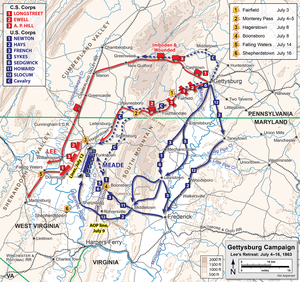| Battle of Williamsport | |||||||
|---|---|---|---|---|---|---|---|
| Part of the American Civil War | |||||||
 The pursuit of Gen. Lee's rebel army by Edwin Forbes | |||||||
| |||||||
| Belligerents | |||||||
|
|
| ||||||
| Commanders and leaders | |||||||
| George G. Meade | Robert E. Lee | ||||||
| Units involved | |||||||
| Army of the Potomac | Army of Northern Virginia | ||||||
| Strength | |||||||
| Divisions | Divisions | ||||||
| Casualties and losses | |||||||
| 1,760 | |||||||
| Gettysburg campaign | |
|---|---|
The Battle of Williamsport, also known as the Battle of Hagerstown or Falling Waters, took place from July 6 to July 16, 1863, in Washington County, Maryland, as part of the Gettysburg Campaign of the American Civil War. It is not to be confused with the fighting at Hoke's Run which was also known as the Battle of Falling Waters.

During the night of July 4–July 5, Gen. Robert E. Lee's battered Confederate army began its retreat from Gettysburg, moving southwest on the Fairfield Road toward Hagerstown and Williamsport, screened by Maj. Gen. J.E.B. Stuart's cavalry. The Union infantry followed cautiously the next day, converging on Middletown, Maryland.
By July 7, Brig. Gen. John D. Imboden stopped Brig. Gen. John Buford's Union cavalry from occupying Williamsport and destroying Confederate trains. On July 6, Brig. Gen. Judson Kilpatrick's cavalry division drove two Confederate cavalry brigades through Hagerstown before being forced to retire by the arrival of the rest of Stuart's command. Lee's infantry reached the rain-swollen Potomac River but could not cross, the pontoon bridge having been destroyed by a cavalry raid.
On July 11, Lee entrenched in a line protecting the river crossings at Williamsport and waited for Maj. Gen. George G. Meade's Army of the Potomac to advance. On July 12, Meade reached the vicinity and probed the Confederate line. On July 13, skirmishing was heavy along the lines as Meade positioned his forces for an attack. In the meantime, the river fell enough to allow the construction of a new bridge, and Lee's army began crossing the river after dark on the 13th.
On the morning of July 14, Kilpatrick's and Buford's cavalry divisions approached from the north and east respectively. Before allowing Buford to gain a position on the flank and rear, Kilpatrick attacked the rearguard division of Maj. Gen. Henry Heth, taking more than 500 prisoners. Confederate Brig. Gen. J. Johnston Pettigrew was mortally wounded in the fight.
On July 16, Brig. Gen. David McM. Gregg's cavalry approached Shepherdstown where the brigades of Brig. Gens. Fitzhugh Lee and John R. Chambliss, supported by Col. Milton J. Ferguson's brigade, held the Potomac River fords against the Union infantry. Fitzhugh Lee and Chambliss attacked Gregg, who held out against several attacks and sorties, fighting sporadically until nightfall, when he withdrew.
Preservation
The American Battlefield Trust and its partners have preserved 3.5 acres of the battlefield at Williamsport through mid-2023.
Gallery
-
 Battlefield core and study areas by the ABPP.
Battlefield core and study areas by the ABPP.
References
- "Falling Waters Battlefield". American Battlefield Trust. Retrieved June 20, 2023.
| Maryland in the American Civil War | |
|---|---|
| Battles | |
| Events | |
| Miscellaneous | |
| Museums | |
| People | |
| Places | |
| Gettysburg campaign | |||||||||
|---|---|---|---|---|---|---|---|---|---|
| Engagements |
| ||||||||
| Confederate commanders | |||||||||
| Union commanders | |||||||||
| Army of the Potomac (order of battle) | |||||||||
| Army of Northern Virginia (order of battle) | |||||||||
| Campaign geography | |||||||||